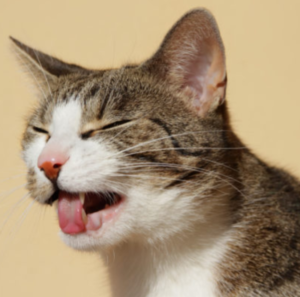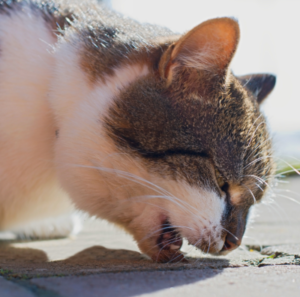 What You Should Do About Hairballs in Cats
What You Should Do About Hairballs in Cats
Cats are incredibly great at keeping themselves clean. They know how to naturally self-groom and do not need bathing frequently. However, during this self-grooming process, they can swallow loose hair leading to a cat hairball. Hairballs in cats refer to a collection of dead hair and digestive juices that have formed in a cat’s stomach. Cat hairballs are usually cylindrical and are vomited by cats as a way of removing unwanted substances. They are a part of cats’ instinctive grooming regime and should not worry you. Kittens and younger cats usually have fewer hairballs as they are fastidious when it comes to grooming. On the other hand, older cats tend to produce hairballs more often. Nonetheless, long-haired cats have the greatest tendency toward hairballs, though any cat develops them as all cats shed.
However, if your furry friend has hairballs frequently, it is worth taking her to your vet as this could mean that all is not well. Numerous hairballs can be an indication that there is a problem in the gastrointestinal tract. In this case, it is best to check this out as soon as possible. Numerous hairballs can also show that your cat is over-grooming. Cats may over-groom when stressed. A stressed cat should be taken to the vet for a checkup.
You may like Best Cat Grooming Gloves.
Causes of Hairballs in Cats
There are two main causes of cat hairballs. The first reason has to do with hair shedding and grooming. Not grooming enough is an issue just as excessive grooming is as they both lead to the formation of hairballs. Long-haired cats shed additional hair during seasonal changes, and therefore this is an important factor to consider when it comes to the formation of hairballs.
Other causes of hairballs in cats include:
- Lack of opportunity to ingest the ballast that stimulates the movement of hair through the intestines naturally
- Motility disorders or the presence of retention pockets in the digestive tract which affect the ability of food to move through the digestive tract
- Inflammatory bowel disease
- Intestinal obstruction
- Physical inactivity slows the passage of food and hair through the digestive tract
- Seasonal changes such as when additional hair is shed
Hairballs in cats can become a problem when they cause blockages. Your furry friend could be suffering from neoplasia, inflammatory bowel disease, or a mobility disorder if it is no longer able to pass hair through their system. In such a scenario, you need to visit the vet to be advised accordingly.
You may also like Best Brushes for Cats.
Symptoms of Hairballs in Cats
It is important to know the signs and symptoms that indicate that your cat is suffering from hairballs. Witnessing and gearing your cat eliminate a hairball can be rather disturbing. It will usually retch, gag, hack and after a while throw up the hairball.
Signs of a life-threatening blockage include:
- Lethargy
- Loss of appetite
- Diarrhea
- Constipation
- Constant hacking, retching, gagging, and vomiting without producing any hairball
- Excessive nibbling on grass
- A stomach that is swollen or sensitive
 What to Do About Hairballs in Cats
What to Do About Hairballs in Cats
- Adding Canned Pumpkin to the Cat’s Food
Pumpkins are essential in preventing hairballs. This is because pumpkins are loaded with fiber and have bending qualities that help in passing hairballs and feces. Ensure that you choose pure pumpkin when adding pumpkin to your feline’s diet. Do not use the type of filling that you would add to a pumpkin pie as it is usually loaded with sugar. Besides, if your cat has a sensitive stomach, it is good to warm up the pumpkin before adding it to their food.
- Add More Fiber to The Cat’s Diet
Adding more fiber to a cat’s diet is one effective way of combating hairballs. Fiber is good for a cat’s diet just as it is for people’s diet. Consider adding a couple of tablespoons of high-fiber cereal to the food that is eaten by your cat to help your cat process the pesky hairballs. This helps to prevent further problems.
- Treat your Furry Friend to a bit of Tuna or Sardine Occasionally
Most cats love a bit of tuna or sardine and this can help with hairballs. This is because canned fish contains a lot of natural oils. Nonetheless, they are usually packed in oil.
- Melt Some Butter and Drizzle it Over your Cat’s Food or Drizzle Some Olive Oil over the Kitty’s Food
Doing both has a similar impact as it helps to ease digestion, and assist the hairball to pass naturally. Drizzling a teaspoon of olive oil or melted butter to your kitty’s food once weekly is enough to help with proper digestion. Having a healthy digestive system is important when controlling cat hairballs. One thing that you should never do, however, is to force olive oil into the cat’s mouth. Rather, ensure that the cat licks the oil naturally. If you don’t, you could send it into the lungs of the cat. This approach helps your four-legged friends to pass the hairball and also reduces stomach pains that may be as a result of the hair. Other oils that are also safe to use include corn oil, mineral oil, and saffron oil.
- Change the Cat Food to Something that Specifically Targets Prevention of Hairball Formation
This is a solution that is well worth considering if your furry friend suffers from hairballs regularly. There are so many different types of pet food to choose from nowadays. There are also some brands that have created a pet food that is designed to combat the formation of hairballs. This is one of the lowest maintenance ways to stop the occurrence of hairballs. These formulas often contain a good quality of fiber, which helps in digestion as well as several other vitamins and oils which play a vital role in ensuring that your cat’s coat and skin are healthy. They also help to ensure that your cat’s coat remains sleek and glossy.
- Complete Every Grooming Session with a Wipe
It is a great idea to use a wipe or a wet paper towel once you are done grooming your beloved cat. This helps to pick up any loose hair that has been a lefty. If you decide to use wipes, ensure that they are fragrance-free and hypoallergenic.
- Grow Indoor Pet Grass
This is an option to consider if you are looking for a natural way to stop the problem. Growing indoor pet grass is not only effective but also a completely natural approach that encourages your cat to consume fiber. Grass also acts as a natural stomach soother. It helps hairballs to move easily through the system.
- Pet your Cat with Conditioner
Using a little bit of conditioner to pet your cat is an easy and effective way of dealing with hairballs. When petting your feline with the conditioner, it is absorbed by the hair, thus keeping it moisturized. This leads to a healthy coat and lowers any shredding. When choosing a conditioner, ensure that you get one that is nontoxic and completely natural.
- Apply Some Vaseline on your Cat’s Paw
Most commercial products available for dealing with hairballs contain petroleum jelly. You will find this in Vaseline, making it a good solution if you do not have time to pop to the pet store or you want something to deal with the problem immediately. All that you have to do is put a very small amount of Vaseline on your cat’s paw. The cat should lick this off voluntarily as it helps to prevent the formation of hairballs.
- Discourage Excessive Grooming
If you suspect that your cat’s hairballs are caused by compulsive grooming, try to train the cat to do another activity that is enjoyable other than licking their coat. This includes teaching them to play with a new toy on their own or having a toy that you can play with together.
- Schedule Regular Haircuts for your Cat
Keeping your cat’s coat trimmed regularly means that the hair she consumes is less likely to become tangled in a hairball. It also has a greater chance of passing through her system without causing any problems. These sessions also promote bonding between the cat and the one grooming her.
- Use a Hairball Laxative
There are various hairball laxatives in the market which help hairballs pass through the digestive tract.
- Surgical Removal
There might be a need for your furry friend to undergo surgery to remove the hairballs from the intestinal tract. This is only an option in a case that is severe and life-threatening.
Conclusion
The last thing that any cat owner would want is to run the risk of your cat suffering an intestinal blockage. Preventing the formation is therefore a necessity for your cat’s health. It is vital for your sake since hairballs can be very unpleasant. Get rid of hairballs easily by following the suggestions mentioned above and hairballs occurring and forming will be a thing of the past for you.
See Also: Vomiting in Cats.
